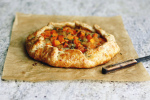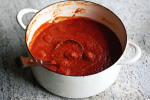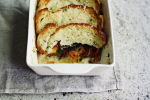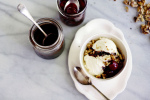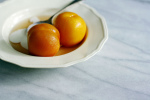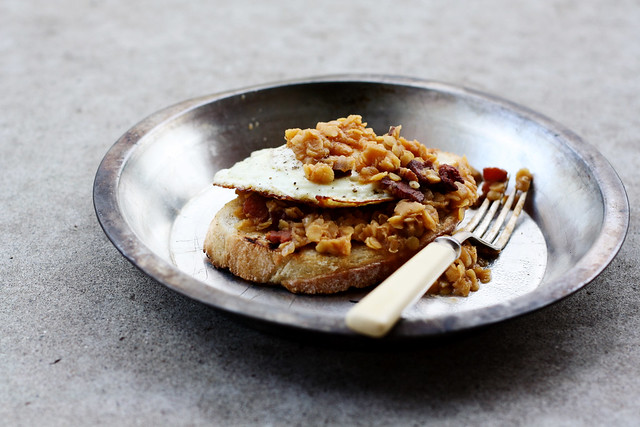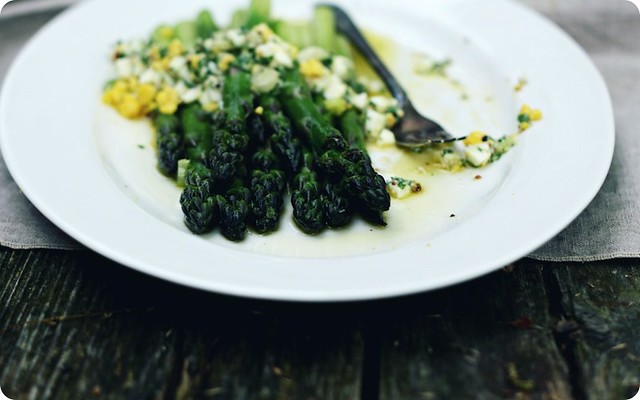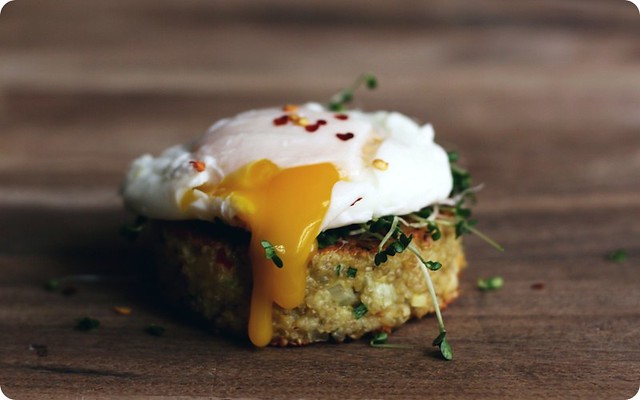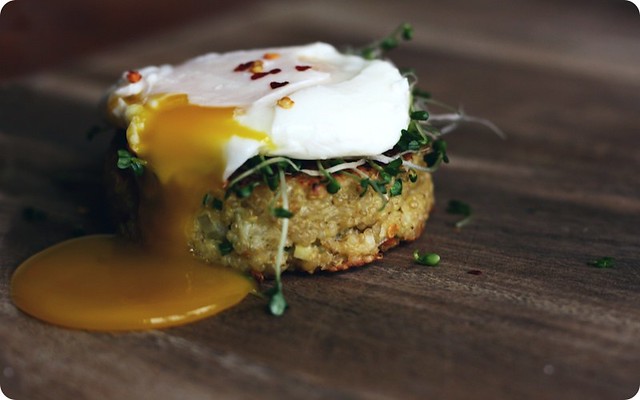Let's return to the lentils
 Tuesday, January 3, 2012 at 10:40AM
Tuesday, January 3, 2012 at 10:40AM It is an unglamourous, unoriginal statement to declare I adore baked beans. But I do.
Since I have a habit of imaging our conversations as dramas in my head, I can hear you saying "those aren't beans, Tara. Those are lentils." And maybe then you'll tilt your head to one side and pat me on my hand in a kind, but vaguely pitying manner. You might cluck your tongue in a soft "tsk, tsk" as what a shame it is that I've obviously lost any and all of my marbles over this holiday and new year season.
You may even put up the kettle for some tea. You're really very nice to me.
However, please have faith in my madness, because look at that - right there, lentils that look like baked beans.
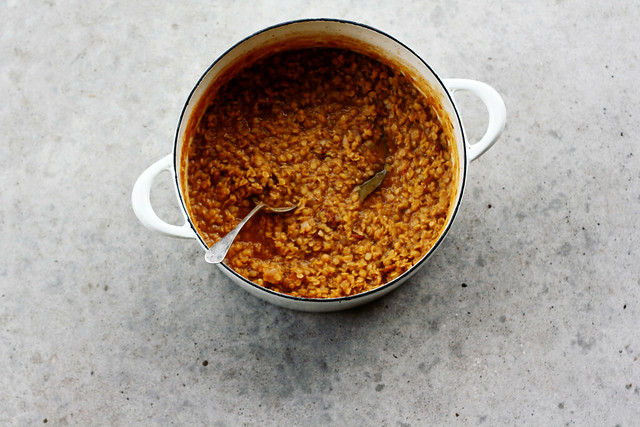
These brilliant beauties are from Frédéric Morin and David McMillian, and the book they wrote with Meredith Erickson, The Art of Living According to Joe Beef (Ten Speed Press, 2011). Morin and McMillian are behind the Montreal-based restaurant Joe Beef, and two other establishments - Liverpool House and McKiernan Lunchonette. The book is more than a cookbook, more of a treatise, a perspective on food and quality of life. That said, it's not mired down by overly-saccharine missives, but instead kept buoyant by bravado and enthusiasm, as evidenced by the included history lesson of eating in their city, a pullout insert of the most majestic smörgåsbord, and a romantic dissertation on train travel.
I flipped through the book for a few minutes one day, then spent a solid two luxurious hours reading it at the kitchen table the next, from beginning to end, while munching a chewy baguette with a smear of sinus-clearing mustard and wafery slices of salty ham. That was a fine morning, and this is a fine book. It's been on a whole whack of "Best of" lists for the year, with good reason.
Recipe origin given it's due, let's return to the lentils.
These lentils run all the same bases as baked beans - a humming balance of acid, fat, sugar, salt and bite (an equation cribbed from Morin and the pages of the book, I should say). The mathematics make sense, and are brought to best potential in a lidded pot. While the sludgy pleasure of baked beans is nothing new, the substitution of lentils in the place of the beans changes the effect entirely. The stewy, starchy charm is kept, but the flat density of the lentils shift and slip across the spoon, and make for a less claustrophobic bite. While not light per se, the lentils have a looseness, an almost hearty delicacy (which makes no sense, I know).
It's a home run.
Of all the ways one can enjoy a bean that's been baked these lentils can play quite admirably; alongside a golden-crisp sausage, or with cabbage that's been lightly braised, or as a part of a Full English Breakfast (the plate in the back). I've nicked some inspiration from the last, by grilling some bread on a cast iron pan, letting it catch and scorch in places, topped the toast with lentils and a frizzled-edged fried egg with the yolk left runny, and then spooned more beans atop that. It's that hearty, glorious fare that works well with coffee, morning, noon, evening and latest night.
The flavours are pretty much the regulars: fat and smoke from bacon, a low sweetness from browned onions and garlic, aromatic roundness from maple syrup, mustard's heat boosted by vinegar's twang. The structure upon which all the other ingredients play upon is, funnily, the ketchup - the combination of tomato and vinegar and sugar - is what gathers everything together. Which is to say it's like a curving, hunched backbone to the dish, as one looks when hunkered over a bowl at the table.
After a quick sauté on the stove and a longer stay in the oven, you are rewarded with a ruddy mix of lentils; it is awfully orange, here and there rusty brown with bacon and a single garnish of a dusky bay leaf. There's a comforting calm to the monochromatic scheme, but it's not fancy-pants stuff. If you'd rather, close our eyes and then grab your fork, or maybe grab the fork first, that might be easier. Either way, make these, eat them, and be happy.
******
There's a superstition that lentils are eaten on the new year because they resemble coins and this bodes well for prosperous days ahead. While I'm three days overdue in my wishes to you, the lapse does not diminish the sincerity of the sentiment. I hope your days have been brightly merry, and nothing but best wishes to you and yours for this year to come.
A quick mention, Donny Tsang invited me to chat about the photographs I take. If you'd like to read the interview, it's at Great Food Photos. Thanks so much Donny for the kindness!
Lentils Like Baked Beans
From The Art of Living According to Joe Beef. "This great side dish has a bit of a Quebecois-lumberjack-in-Bollywood taste. It is red lentils cooked like dal, seasoned like baked beans. It is a pork chop's best friend or will mate with a hefty breakfast."
4 slices bacon, finely chopped
1 yellow onion, finely diced
1/2 teaspoon minced garlic
2 cups (500 millilitres) red lentils, rinsed and picked over
4 cups (1 litre) water
1/4 cup (60 millilitres) ketchup
2 tablespoons maple syrup, plus more as needed
2 tablespoons neutral oil
2 tablespoons Colman's mustard powder
1 tablespoon cider vinegar, plus more as needed
1 teaspoon ground pepper, plus more as needed
1 bay leaf
Salt
Preheat the oven to 350°F (180°C).
In oven proof pot with lid, fry bacon over medium-high heat until crisp. Add the onion and cook, stirring, for about 4 minutes, or until softened. Then add the garlic and cook for 1 minute longer.
Add the lentils, water, ketchup, maple syrup, oil, mustard, vinegar, pepper and bay leaf. Stir well and season with salt. Bring to a boil. Cover, place in oven, and bake for 45 minutes, or until lentils are tender.
Taste and correct the seasoning with salt, pepper, maple syrup, and vinegar. Serve hot now or later.
Serves 4.
Notes from Tara:
- When it comes to lentils, they need a good wash - a quick rinse in a sieve doesn't always do the job. I cover them with water in a bowl, give them a swish with my hand, strain, and repeat, until the water is no longer cloudy.
- The bacon I had was rather thick cut, and so produced a good amount of fat. As a result, I didn't use the full 2 tablespoons of oil. I also squirreled away a few of the bits of crisp bacon before adding the lentils, reserving them to add at the table.
- I used some homemade ketchup, which has things like celery seed, clove, mace, allspice, cinnamon, chili flakes in it; for those so inclined, you could make up a sachet of these spices and steep them into the liquid for the baking. I've not tried it, so fair warning. Sounds like a nice idea though.


